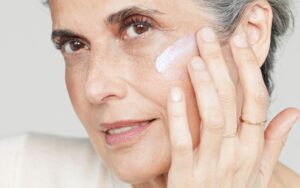
Immediately below our epidermis, in the second layer of the skin, there are the proteins collagen and elastin. Collagen forms a network, a mesh that supports the skin, gives it firmness. Elastin is a protein that gives elasticity, which enables the skin to return to its position when stretched. As the years pass these proteins are produced at a lower rate and are broken down more quickly. So when they are reduced, sagging and wrinkles appear on the skin. Some people show more sagging, others more wrinkles. This depends on our genes.
Menopause, i.e. the significant decrease in estrogen, significantly accelerates this process. Consider that women in the first 5 years from its onset we lose approximately 30% of our skin's collagen. And skin elasticity in postmenopausal women decreases by 0.55% per year.
What external factors increase relaxation during menopause?
Also, it is very important the role of the environment in this reduction of the substances that give a youthful image to our skin. Diet, smoking, sleep clearly have a role in skin aging. However, the most aggravating factor from the environment remains the exposure to the sun. Ultraviolet radiation it destroys the elasticity of the skin in the areas that have been exposed for decades, and it is the main factor responsible for sagging and wrinkles on the face, neck, hands as well as the sagging of the skin on the body.
Skin relaxation can also be affected the big weight loss and the redistribution of fat that occurs with age. It is a myth that running causes relaxation and that relaxation is linked to how we sleep.
What do we do for relaxation?
1. Prevention by avoiding the sun.
2. Long-term application of topical retinoids, antioxidants, peptides.
3. In addition, our dermatologist advises us on possible in-office treatments aimed precisely at preventing or correcting sagging.






No comment yet, add your voice below!